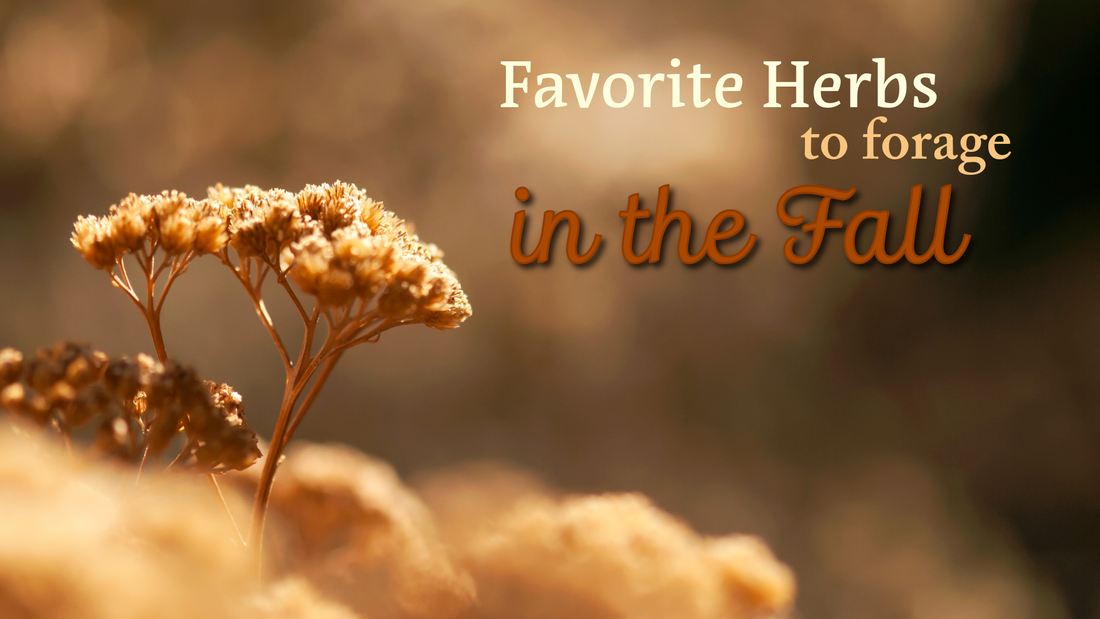
Favorite Herbs to Forage in the Fall
Share
As the air turns crisp and the leaves shift into gold, autumn invites us back to the land in a different way. Foraging in the fall is about slowing down, noticing what still thrives after summer’s abundance, and gathering plants that support the colder months ahead. Here are some of our favorite herbs to forage by region—always with care, gratitude, and respect for the ecosystems we step into.
Pacific Northwest (PNW)
Oregon Grape Root (Mahonia aquifolium)
Found along shaded forest edges and in the understory, Oregon grape root is a fall forager’s gem. Its yellow roots glow when unearthed, reminding us of the bright strength plants hold underground. Harvest sparingly and only from established stands—small amounts go a long way, and ethical harvesting keeps this vibrant understory plant thriving.
Rose Hips (Rosa spp.)
As the last petals fall away, rose hips swell into ruby-colored fruits. Along riversides and woodland trails, these vitamin-rich berries shine after the first frost. Rose hips carry the sweetness of summer forward, offering nourishment for teas, syrups, and seasonal rituals of warmth.
Southwest
Prickly Pear (Opuntia spp.)
Come fall, prickly pear cactus bears both sweet fruits (tunas) and nutrient-rich pads (nopales). Its deep magenta fruits can be turned into syrups or jams, carrying the desert sun into the colder months. The cactus, with its spines and sweetness, reminds us of balance between protection and generosity.
Desert Lavender (Hyptis emoryi)
This aromatic shrub blooms late into the season, and its silvery-green leaves carry a soft lavender-mint scent. Found along desert washes, desert lavender is often used as a soothing tea or simply bundled as a fragrant plant ally. Its presence in the cooler fall months offers a gentle reminder of calm in the stark desert landscape.
Southeast
Goldenrod (Solidago spp.)
Fields and roadsides glow golden in the fall with the tall plumes of goldenrod. Once unfairly blamed for seasonal allergies, goldenrod is actually an important pollinator ally and a sign of seasonal change. Foragers use it for teas and tinctures, carrying the sunlit energy of late summer deep into autumn. While many blame Goldenrod for allergies, this magical herb could actually be great plant ally for seasonal allergies.
Persimmon (Diospyros virginiana)
Native persimmons ripen in the fall, often after the first frost softens their astringency. Sweet, rich, and grounding, they can be gathered from woodland edges and old homesteads. Folklore says the shape of the persimmon seed can predict the coming winter—knife, spoon, or fork—an old farmer’s way of reading the season ahead.
Upper East Coast
Mugwort (Artemisia vulgaris)
Often growing along roadsides and field edges, mugwort’s silvery leaves remain vibrant into the fall. Long used in dream work and ritual practices, it is a plant of transition—guiding us between seasons, between waking and dreaming. Fall foragers may gather mugwort for smudge bundles or teas to carry its protective and visionary qualities.
Yarrow (Achillea millefolium)
Though often thought of as a summer herb, yarrow’s feathery leaves stay green well into fall, even after its flowers fade. Found in meadows, field edges, and roadsides, yarrow has been a steadfast companion plant for centuries. Fall foragers can gather its leaves for drying and future use, carrying a thread of summer vitality into the darker months.
Foraging with Care
Wherever you are, foraging is about more than gathering—it’s about relationship. Harvest only what you need, never take the first or last plant you see, and always give thanks. By honoring the land and its cycles, we carry ancient traditions forward and keep our ecosystems thriving.
What are your favorite plants to forage in the fall? Share your seasonal rituals with us—we’d love to hear how the land speaks to you where you are.
by Andi Keller of Andilions Garden
